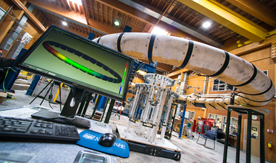
UMaine’s inflatable technology expertise utilized by NASA, U.S. Army
The Curiosity Rover took a selfie June 24 to celebrate its one Martian-year anniversary — 687 Earth days — on the Red Planet.
If NASA perfects its Hypersonic Inflatable Aerodynamic Decelerator (HIAD), a spacecraft nose-mounted “giant cone of inner tubes” stacked like a ring toy, one day people also may be taking selfies on the fourth planet from the Sun.
The HIAD slows a spacecraft as it enters a planet’s atmosphere. The technology, says NASA, is intended to make it possible for a spaceship large enough to carry astronauts and heavy loads of scientific equipment to explore Mars — 34,092,627 miles from Earth — and beyond.
Bill Davids, Joshua Clapp, Andrew Goupee and Andrew Young — engineers with University of Maine’s Advanced Structures and Composites Center — are working with NASA to accomplish that mission.
The out-of-this world opportunity isn’t the first impressive inflatable technology to be worked on by UMaine Composites Center engineers.
First there was the groundbreaking Bridge-in-a-BackpackTM, so named because each deflated bridge arch fits into a Black Bear hockey equipment bag.
The award-winning, patented Bridge-in-a-BackpackTM has earned the American Association of State Highway and Transportation Officials’ certification. Bridges similar to those in Belfast, North Anson and Pittsfield, Maine, as well as those in Massachusetts and Michigan, can be built around the country and world. One was built in the Caribbean, says Habib Dagher, Bath Iron Works Professor and founding director of the world-renowned research and development center.
The bridges — stronger than steel and able to be built in a couple of weeks — are made of light, portable carbon-fiber tubes that are inflated, formed into arches and infused with resin. Concrete is poured inside the carbon fiber tubes, which protect the concrete from water and other natural elements, thus extending the bridge’s lifespan to double or triple that of a traditional bridge.
Following Bridge-in-a-BackpackTM, Davids, chair of the civil and environmental engineering department and the John C. Bridge Professor, led a UMaine group that worked on portable, lightweight, rapidly deployable inflatable fabric arch-supported structures for the U.S. Army Natick Soldier Systems Center.
Designed for military forces, the tents supported by inflatable arches also can be used for disaster relief shelters, temporary medical facilities and storage.
The research involving inflatable fabric arch-supported structures caught the attention of NASA scientists several years ago. NASA officials working on HIAD inflatable technology contacted Davids about possible research collaborations.
Ultimately, Davids’ research proposal on the structural investigation of the HIAD technology to NASA-EPSCoR through the Maine Space Grant Consortium was accepted. UMaine is now about 17 months into the three-year, $750,000project funded by NASA and EPSCoR. The Maine Space Grant Consortium administers the funds.
Dagher says it’s fascinating how one research discovery gives rise to another idea in a completely different field. “The beauty is you don’t know where you’re going to end up in the discovery process. One research discovery leads to another. It’s a big roller coaster,” he says.
UMaine engineers have weekly telecoms with NASA project officials as they strive to make this promising technology a reality.
“Our role is to fill in holes in NASA’s technical knowledge,” says Davids. “They have developed the technology; we help them advance it through testing the structures in the lab and analyzing stresses and deformations in the HIADs.”
Davids and Clapp say the HIAD technology is viewed as one of the most, if not the most, feasible options for a successful human spaceflight to Mars and has the potential to allow landing at higher elevations on the planet, carrying more payload, or both.
Payloads that have landed on Mars to date have had a mass less than 1 metric ton; 40-80 metric tons likely will be required for a mission that includes people, says Clapp, a doctoral student and research engineer.
Also, all Mars landings thus far have been below -1.4 kilometer Mars Orbiter Laser Altimeter (MOLA) elevation due to the vertical distance required for deceleration. A number of scientifically interesting sites are at higher elevations, Clapp says.
UMaine researchers are working on a 6-meter diameter HIAD tested at NASA’s National Full-Scale Aerodynamics Complex — the largest wind tunnel in the world — in Moffett Field, California.
“The 6-meter HIAD created the most air blockage of anything ever tested in the wind tunnel and pushed the limits of the equipment to the maximum,” Clapp says. “The HIAD diameter needed for a manned mission to Mars is estimated to be on the order of 20 meters, therefore we will not be able to conduct aerodynamic testing in a wind tunnel, which makes a reliable predictive tool (i.e. the finite element models that we’re all working on) that much more important.”
Dr. Neil Cheatwood, principal investigator with the Inflatable Reentry Vehicle Experiment (IRVE-3) — a precursor to HIAD — says in a NASA video that if funding was not a concern, he estimated people could be on Mars, where temperatures range from minus 195 F to 70 F, by 2020.
Keeping with the space theme, Dagher says with a smile that the Advanced Structures and Composites Center, much like Star Trek’s starship Enterprise, allows people to boldly go where no one has gone before.
Contact: Beth Staples, 207.581.3777
